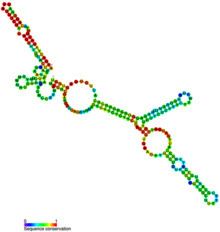Symbol U3 Rfam RF00012 HUGO 10176 | Alt. Symbols RNU3P2, Entrez 26844 OMIM 180710 | |
 | ||
U3 snoRNA is a non-coding RNA found predominantly in the nucleolus. U3 has C/D box motifs that technically make it a member of the box C/D class of snoRNAs; however, unlike other C/D box snoRNAs, it has not been shown to direct 2'-O-methylation of other RNAs. Rather, U3 is thought to guide site-specific cleavage of ribosomal RNA (rRNA) during pre-rRNA processing.
The box C/D element is a subset of the six short sequence elements found in all U3 snoRNAs, namely boxes A, A', B, C, C', and D. The U3 snoRNA secondary structure is characterized by a small 5' domain (with boxes A and A'), and a larger 3' domain (with boxes B, C, C', and D), the two domains being linked by a single-stranded hinge. Boxes B and C form the B/C motif, which appears to be exclusive to U3 snoRNAs, and boxes C' and D form the C'/D motif. The latter is functionally similar to the C/D motifs found in other snoRNAs. The 5' domain and the hinge region act as a pre-rRNA-binding domain. The 3' domain has conserved protein-binding sites. Both the box B/C and box C'/D motifs are sufficient for nuclear retention of U3 snoRNA. The box C'/D motif is also necessary for nucleolar localization, stability and hyper-methylation of U3 snoRNA. Both box B/C and C'/D motifs are involved in specific protein interactions and are necessary for the rRNA processing functions of U3 snoRNA.
Species-specific secondary structure models
S. cerevisiae secondary structure determined by chemical mapping of U3A RNA in a purified snoRNP is available. A human structure model has also been proposed. Like yeast and human, protozoan protist Entamoeba histolytica : a primitive eukaryote adopted the same conserved secondary structure of U3 snoRNA. Four consensus structures specific to metazoa, fungi, plants and basal eukaryotes have been proposed.
